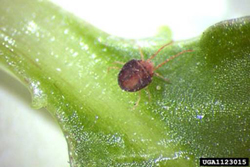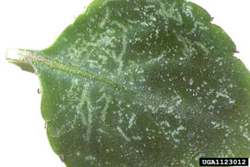DACF Home → Bureaus & Programs → Maine Forest Service → Forest Health & Monitoring → Forest Pest Index → Clover Mites
Clover Mites
Bryobia praetiosa (Koch.)

Photo: Rayanne Lehman, Pennsylvania Department of Agriculture, Bugwood.org
In spring and fall, tiny brown or reddish mites, the size of a pinhead, may be seen crawling on windows and over walls and furniture in the home. These are clover mites, which cause no harm or damage in the home, but constitute an annoyance by their presence in large numbers.
Hosts
These mites normally feed on lawn grasses, clovers, and lawn weeds, and their populations may build up to tremendous numbers. They seek sheltered places for egg laying such as under bark of trees, and to escape extreme high or low temperatures. In their searching they may enter houses in large numbers. Since they are most active at temperatures between 45 and 65 degrees, they are primarily seen until June and after September.

Photo: Rayanne Lehman, Pennsylvania Department of Agriculture, Bugwood.org
Life History
The eggs are laid at the base of trees or small plants in the fall. These hatch early in the spring and the young mites rapidly develop to adults. A second generation occurs in late summer. Injury to plants from their feeding may be severe at times.
Control
The mites sometimes disappear during the summer even in the absence of treatment. One helpful measure is to maintain a 20 to 30 inch wide grass-free area around the foundation to discourage mites from entering the home. Any of the following chemicals which are available wherever garden supplies are sold can be used where relief is sought when used in accordance to label directions.
Indoors, the nuisance can be relieved by treating window frames, baseboards, and underside of windows with dicofol (Kelthane), diluted and applied according to label directions for indoor use. Household formulations of propoxur (Baygon) or diazinon may also be used for indoor control.
Outdoors, the source of the mites should be treated by applying dicofol (Kelthane) to the lawn and foundation plantings. Diazinon applied in a five foot band of soil around the house next to the foundation will also control these mites.
NOTE: Pesticide recommendations are contingent on continued EPA and Maine Board of Pesticides Control registration and are subject to change.
Caution : or your own protection and that of the environment, apply the pesticide only in strict accordance with label directions and precautions.
MAINE DEPARTMENT OF AGRICULTURE, CONSERVATION AND FORESTRY
Maine Forest Service - Forest Health and Monitoring Division
April 2000